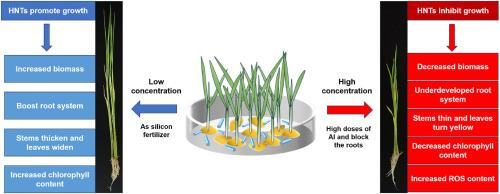Phytotoxicity of HNTs to rice (Oryza sativa L.): Effects on rice growth and development
IF 8.1
2区 环境科学与生态学
Q1 ENVIRONMENTAL SCIENCES
引用次数: 0
Abstract
The phytotoxicity of halloysite nanotubes (HNTs) to rice (Oryza sativa L.) was evaluated at several stages from germination, seedling growth to spike setting, and the seedling stage was selected to study the effect of HNTs on the growth of rice. Rice was cultured using different concentrations of HNTs dispersions and a blank control group was cultured with deionized water. It was found that HNTs did not affect the germination of rice seeds, and at the seedling stage, the low concentration of HNTs dispersion (0.1 mg mL−1) promoted the growth of rice. This significantly increased the biomass and root system of rice seedlings and also promoted the development of stems and leaves of rice seedlings. However, high concentration of HNTs dispersion (100 mg mL−1) had an inhibitory effect on rice growth, resulting in a significant decrease in rice biomass, causing oxidative damage (increase in H2O2 content and malondialdehyde content, and disruption of cell membrane permeability), and causing a decrease in chlorophyll content in rice. The rice seedlings treated with HNTs were transplanted into the soil, and it was found that all the rice could grow healthily. The growth trend was consistent with the seedling stage, and all groups of rice were able to produce spikes, which indicated that the effect of HNTs on rice was slight. In total, this work displayed the toxicity of HNTs to rice, which lays the foundation for the application of HNTs in agricultural field.

HNTs 对水稻(Oryza sativa L.)的植物毒性:对水稻生长和发育的影响
在水稻(Oryza sativa L.)从发芽、幼苗生长到抽穗的几个阶段评估了霍洛石纳米管(HNTs)的植物毒性,并选择幼苗阶段研究 HNTs 对水稻生长的影响。使用不同浓度的 HNTs 分散液培养水稻,空白对照组使用去离子水培养。结果发现,HNTs 不影响水稻种子的发芽,而在幼苗期,低浓度的 HNTs 分散液(0.1 毫克-毫升-1)促进了水稻的生长。这明显增加了水稻秧苗的生物量和根系,也促进了水稻秧苗茎叶的发育。然而,高浓度 HNTs 分散液(100 毫克-毫升-1)对水稻生长有抑制作用,导致水稻生物量显著下降,造成氧化损伤(H2O2 含量和丙二醛含量增加,细胞膜通透性破坏),并导致水稻叶绿素含量下降。将经过 HNTs 处理的水稻秧苗移栽到土壤中,发现所有水稻都能健康生长。各组水稻的生长趋势与幼苗期一致,均能抽穗,表明 HNTs 对水稻的影响轻微。总之,这项研究显示了 HNTs 对水稻的毒性,为 HNTs 在农业领域的应用奠定了基础。
本文章由计算机程序翻译,如有差异,请以英文原文为准。
求助全文
约1分钟内获得全文
求助全文
来源期刊

Chemosphere
环境科学-环境科学
CiteScore
15.80
自引率
8.00%
发文量
4975
审稿时长
3.4 months
期刊介绍:
Chemosphere, being an international multidisciplinary journal, is dedicated to publishing original communications and review articles on chemicals in the environment. The scope covers a wide range of topics, including the identification, quantification, behavior, fate, toxicology, treatment, and remediation of chemicals in the bio-, hydro-, litho-, and atmosphere, ensuring the broad dissemination of research in this field.
 求助内容:
求助内容: 应助结果提醒方式:
应助结果提醒方式:


